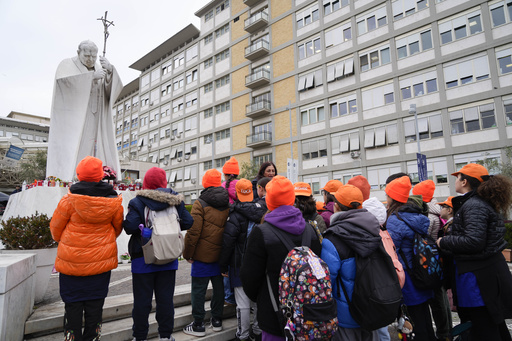LONDON – Officials from the Vatican have announced that Pope Francis is battling pneumonia in both lungs, adding to the challenges of his recovery. The 88-year-old pontiff was admitted to a hospital on Friday after experiencing a week of worsening bronchitis. On Monday, medical professionals revealed that he had contracted a combination of infections impacting his respiratory system.
On Wednesday, the Vatican reported that Pope Francis had a restful night, woke up feeling refreshed, and enjoyed his breakfast, indicating he was in good spirits. This article explores the implications of his pneumonia diagnosis and what medical teams will be monitoring moving forward.
What transpired?
Pope Francis was taken to Gemelli Hospital in Rome in a “fair” state on Friday as his bronchial condition intensified. By Monday, doctors confirmed he was dealing with a polymicrobial respiratory tract infection, which involves a mix of viruses, bacteria, and potentially other microorganisms affecting his respiratory system. A chest scan conducted on Tuesday revealed he had pneumonia in both lungs, prompting the need for further medical intervention.
Bronchitis results from the inflammation of the bronchial tubes in the lungs, leading to symptoms such as coughing and mucus production. This condition can sometimes escalate, resulting in pneumonia, which is characterized by lung inflammation.
Assessing the severity
Pneumonia can be a serious condition for anyone, especially for someone of the pope’s age, as it poses potential life-threatening risks. Dr. Meredith McCormack, director of pulmonary and critical care medicine at Johns Hopkins University, stated, “Older age, particularly anyone over 65, is a risk factor for more severe infections.” Although the pope underwent lung surgery decades ago, which saw part of his right lung removed, McCormack reassured that this should not significantly hinder his recovery. She added that frailty, indicated by heavy reliance on a wheelchair—which the pope has used for over two years—could increase vulnerability to complications.
Nevertheless, reports indicate that the pope is not confined to his bed. He has been able to enjoy meals, get out of bed, and maintain normal heart function, according to Vatican reports. Dr. Andrew Chadwick, a respiratory and intensive care expert at Oxford University Hospitals, highlighted these behaviors as positive indicators, emphasizing that the pope’s daily progress is a good sign for favorable outcomes.
Available treatments
Treatment for pneumonia typically includes antibiotic therapies, alongside various support measures such as supplemental oxygen for lung recovery. Steroids and antibiotics are expected to play a pivotal role in the pope’s treatment, along with personalized nursing care and chest physiotherapy.
Physiotherapy can assist patients in removing fluid buildup in the lungs, particularly for those with limited mobility. McCormack noted that patients with severe pneumonia often require treatment for one to two weeks, but older individuals might face extended recovery periods.
Monitoring the recovery
Medical professionals’ primary focus in the upcoming days will be to ensure the pope’s condition remains stable and does not worsen. McCormack explained, “If he maintains his current state while combating the infection and demonstrates gradual improvement, that would be a positive indication.”
Chadwick stressed that the initial 72 hours are crucial for a substantial improvement, stating that subsequent recovery phases may progress more slowly for elderly patients. Dr. Maor Sauler, specializing in adult pulmonary care at Yale University, reiterated that though pneumonia treatment is usually effective, age can drastically affect the lungs’ ability to recuperate. “While pneumonia is treatable, it remains a leading cause of death in some cases despite extensive medical efforts,” he noted.




